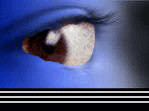|
The catalyst for and core of this work is a low resolution, black and white photograph of Sigmar Polke’s
Vase painting of 1964, in which he both exemplified and debunked a style of fine-art still life representation. By contextualizing
the work in his Showpiece, Polke invested further layers of meaning both to the Vase painting itself and into the relationship
between the work and other items in the installation. By appropriating this image and working it - in series, in Photoshop
- I have subjected the image to a process of industrialisation and invested it with altered ironies and new meanings alien
to, but not unrelated to the work’s original author. I am unabashed by this appropriation. Polke – with whom I
share some common cultural roots- wrote – “ I like my art to be informed by the art of the past, by my roots.
I cannot forget what my ancestors have done…..You cannot exist in a vacuum. You are rooted in time.” And I agree.
The cod ‘artistic’ colouration and prettification evident in this series of six re-workings of the vase image
both reinforces and questions the high art ideals targeted by Polke and serves as an ironic commentary on the conflicting
notions of beauty in the high art versus low art debate initiated by Polke’s work. In Photoshop, each of my six vases
has literally been transformed into a vessel for a flower arrangement. Neither the long established high art tradition of
botanical painting nor the low art post World War Two cultural implications of flower arranging in an age of austerity, as
a socially expected female activity should go unnoticed here. The debate is intensified as the flowers are all lifted from
the sort of Calendar sent every Christmas by colonial aunties - to remind you of their existence and to make you feel guilty
about that Christmas card you really did mean to write. The fact that this Calendar was sent by an auntie in Australia renders
the flowers low art by definition of medium and by act of botanical historicism. These appropriated, prettified and florally
augmented images are further contextualized. Beside each is placed a snapshot photograph taken in the area of France where
I live. The inclusion of these snapshots in the work serves several functions. Firstly, they personalize and de-Polke-ize
the work and make his vase my own. Secondly they function in the same way as Polke’s installation did. By juxtaposition
with the vase image – they further contextualize the work and add new layers of meaning. Whilst snapshots may be a low
art medium, these are high art in content and in implication and inferred meaning. They are representational in that they
are largely untouched by Photoshop. But each snapshot projects a different notion of beauty. As these range from the formal
beauty of the outline of a telegraph pole against a solid cobalt blue to the pantheistic sweep of a lowering landscape and
a storm swept sky - each notion of beauty is substantially different and individuated and each sets up a dialogue with its
accompanying vase image. Thus serving to intensify the ongoing debate. The ivorine craquellette texturalized border - developed
exclusively in Photoshop - literally wraps up the work in all the charm of Golders Green Chic and adds a final twist to its
ironic statement. I only wish I could get Photoshop to do Diamante.
|

